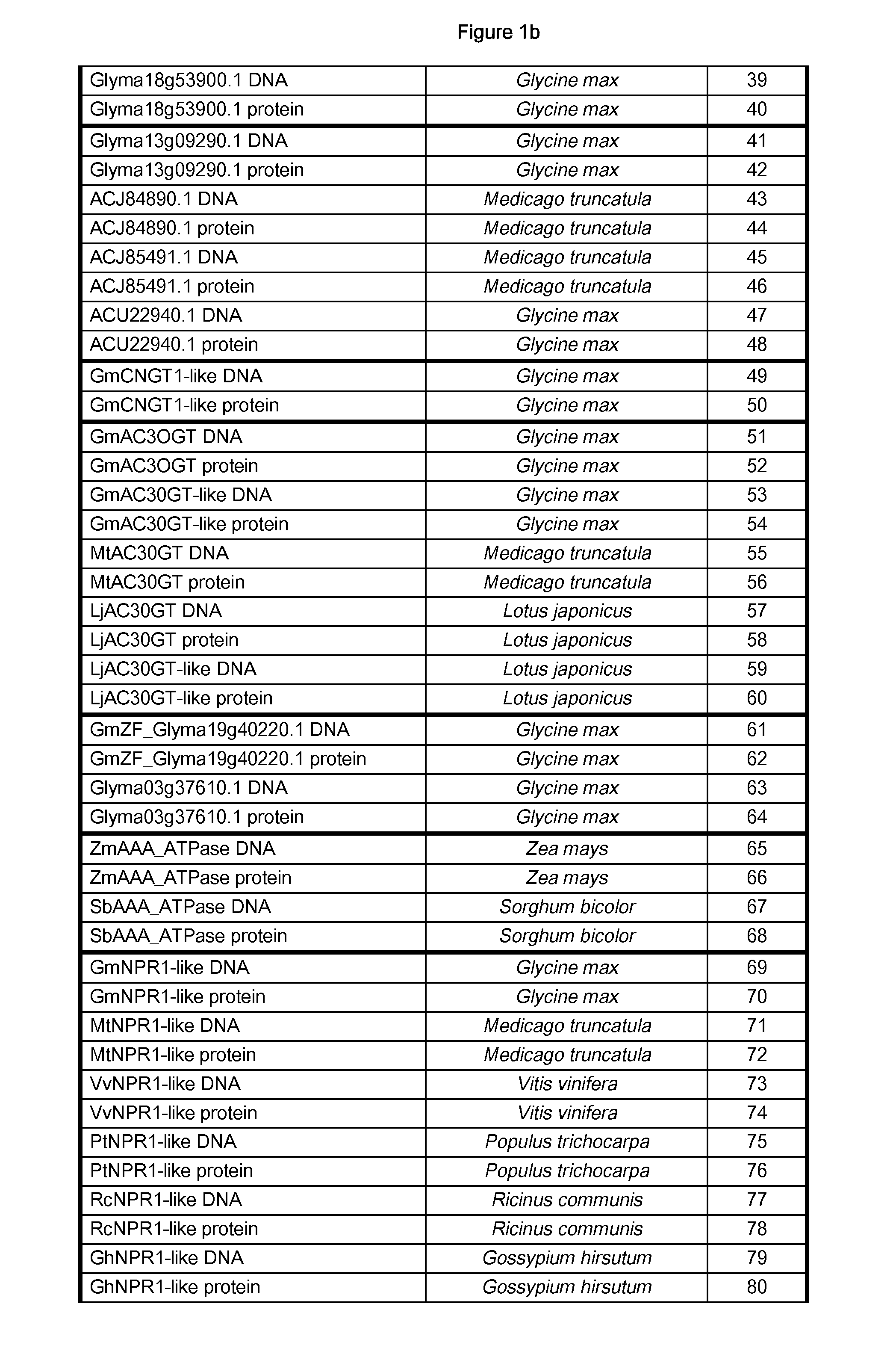Nematode-Resistant Transgenic Plants
- Summary
- Abstract
- Description
- Claims
- Application Information
AI Technical Summary
Benefits of technology
Problems solved by technology
Method used
Image
Examples
example 1
Vector Construction
[0076]PCR was used to isolate DNA fragments used to construct the binary vectors described in Table 1 and discussed in Example 2. The PCR products were cloned into TOPO pCR2.1 vectors (Invitrogen, Carlsbad, Calif.), and inserts were confirmed by sequencing. Open reading frames described by the genes designated GmAHBT1 (SEQ ID NO:1), GmSRG1 (SEQ ID NO:3), MtHPT4 (SEQ ID NO:15), GmEREBP1 (SEQ ID NO:27), Glyma03g32740.1 (SEQ ID NO:37), Glyma18g53900.1 (SEQ ID NO:39), Glyma13g09290.1 (SEQ ID NO:41), GmCNGT1-like (SEQ ID NO:49), GmAC30GT (SEQ ID NO:51), GmZF_Glyma19g40220.1 (SEQ ID NO:61) and ZmAAA_ATPase (SEQ ID NO:65) were isolated using this method.
[0077]The GmNPR1-like gene (SEQ ID NO:69) was synthesized to construct the binary vectors described in Table 1 and discussed in Example 2 and Example 3. The synthesized DNA sequence was cloned into a TOPO pCR2.1 vector (Invitrogen, Carlsbad, Calif.), and the insert was confirmed by sequencing.
[0078]The cloned GmSRG1 (SEQ ...
example 2
[0079]A bioassay to assess nematode resistance conferred by the polynucleotides described herein was performed using a rooted plant assay system disclosed in commonly owned copending U.S. Pat. Pub. 2008 / 0153102. Transgenic roots were generated after transformation with the binary vectors described in Example 1. Multiple transgenic root lines were sub-cultured and inoculated with surface-decontaminated race 3 SCN second stage juveniles (J2) at the level of about 500 J2 / well. Four weeks after nematode inoculation, the cyst number in each well was counted. For each transformation construct, the number of cysts per line was calculated to determine the average cyst count and standard error for the construct. The cyst count values for each transformation construct was compared to the cyst count values of an empty vector control tested in parallel to determine if the construct tested results in a reduction in cyst count. Rooted explant cultures transformed with vectors RTP...
example 3
Homolog Identification and Description
[0080]As disclosed in Example 2, expressing a GmSRG1 transcript contained in vectors RTP1897-1 or RTP3859-1 results in reduced cyst counts when operably linked to a Super or AtTPP promoter and expressed in soybean roots. As disclosed in Example 1, the transcript contains an open reading frame with DNA sequences disclosed as SEQ ID NO:3 and the amino acid sequences disclosed as SEQ ID NO:4. The amino acid sequences described by SEQ ID NO:4 were used to identify similar genes from soybean and other plant species described by SEQ ID NO: 6, 8, 10, 12, and 14 with corresponding DNA open reading frame sequences described by SEQ ID NO:5, 7, 9, 11, 13. The amino acid alignment to SEQ ID NO:4 is shown in FIG. 2. The global percent identity between SEQ ID NO:4 and SEQ ID NO:6 is 75%, the global percent identity between SEQ ID NO:4 and SEQ ID NO:8 is 69%, the global percent identity between SEQ ID NO:4 and SEQ ID NO:10 is 73%, the global percent identity b...
PUM
| Property | Measurement | Unit |
|---|---|---|
| Electrical resistance | aaaaa | aaaaa |
Abstract
Description
Claims
Application Information
 Login to View More
Login to View More - R&D
- Intellectual Property
- Life Sciences
- Materials
- Tech Scout
- Unparalleled Data Quality
- Higher Quality Content
- 60% Fewer Hallucinations
Browse by: Latest US Patents, China's latest patents, Technical Efficacy Thesaurus, Application Domain, Technology Topic, Popular Technical Reports.
© 2025 PatSnap. All rights reserved.Legal|Privacy policy|Modern Slavery Act Transparency Statement|Sitemap|About US| Contact US: help@patsnap.com



